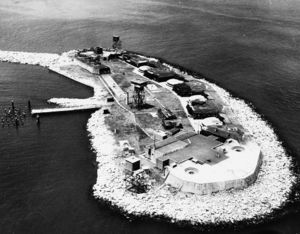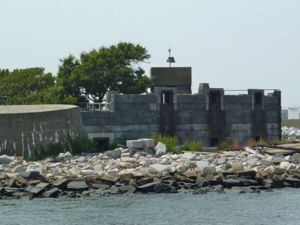Fort Wool (1)
Fort Wool (1) (1826-1946) - First named Fort Calhoun and renamed Fort Wool in 1862 during the U.S. Civil War for Union General John E. Wool. Conceived in 1817 and built on an artificial island southeast of Fort Monroe. It served to guard Virginia's Hampton Roads harbor through World War II. It became a Hampton City Park in 1970.
 |
 |
 | |
History of Fort Wool
Part of the Harbor Defense of Chesapeake Bay.
Construction began on the artificial island in 1818 and by 1823 had raised the island to a height of six feet above high tide and construction of the fort itself was begun. Fort Wool was to have three tiers of casemates and a barbette tier ( 4 tiers designed to mount 232 guns). About half of the second casemate and one tier was completed when work stopped in 1830 because the island was sinking at a rate of eight inches a year. Additional stone was added to the island and work resumed on the casemates in 1858. The U.S. Civil War halted construction.
2nd Lt. Robert E. Lee was stationed at Fort Monroe between 1831 and 1834 and paticipated in the construction of both Fort Monroe and Fort Calhoun(Wool). Lee's participation in the construction of Fort Calhoun(Wool) was limited to tasks involving the addition of more stone to island itself. His immediate supervisor was Captain Andrew Talcott who was in charge of construction at both forts.¹
Endicott Period
Five Endicott Period gun batteries were built between 1902 and 1908. Four of the batteries were built as a main gun line facing north and the fifth battery faced south.
| Battery Click on Battery links below |
No. | Caliber | Type Mount | Service Years | Battery Cost | Notes |
|---|---|---|---|---|---|---|
| Battery Claiborne | 2 | 6" | Disappearing Carriages | 1903-1908-1908-1918 | $ 55,000 | Guns to Battery Gates 1918 |
| Battery Dyer | 2 | 6" | Disappearing Carriages | 1903-1908-1908-1917 | $ 55,000 | Guns to France 1917 |
| Battery Gates | 2 | 6" | Disappearing Carriages | 1903-1908-1908-1942 | $ 55,000 | Converted to Battery 229 |
| Battery Hindman | 2 | 3" | Pedestal Mount | 1903-1905-1905-1946 | $ 13,444 | |
| Battery Lee (2) | 4 | 3" | Pedestal Mount | 1902-1905-1905-1943 | $ 40,000 | Guns & carriages to Fort Story |
| Source: CDSG | ||||||

World War I
Fort Wool was garrisoned during World War I but the War in Europe caused a shift in armament. Battery Dyer and Battery Gates had their gun tubes shipped to other locations. The guns tubes in Battery Claiborne were shifted to Battery Gates. Battery Claiborne and Battery Claiborne remained unarmed.
World War II
Fort Wool was garrisoned during World War II but all of the remaining armament was obsolete and construction began on a new 200 series battery in 1943. All of the obsolete guns were removed by 1943 except the two 3" guns in Battery Hindman. The new Battery 229 was completed in 1944 but was never armed because the threat had diminished.
| Battery Click on Battery links below |
No. | Caliber | Type Mount | Service Years | Battery Cost | Notes |
|---|---|---|---|---|---|---|
| Battery 229 | 2 | 6" | Shielded LR Barbette | 1943-1944-1944-NA | $ 262,330 | Located on old Battery Gates |
| Source: CDSG | ||||||
Current Status

Fort Wool was turned over to the State of Virginia in 1967 and it became a Hampton City Park in 1970. The fort is accessed by daily tour boat trips from Hampton on the Miss Hampton II tour boat.
|
{"selectable":false,"width":"500"} |
Location: Located in Virginia's Hampton Roads harbor on a man-made island adjacent to the Hampton Roads Bridge Tunnel entrance. Access by boat. Maps & Images Lat: 36.98592 Long: -76.30122 |
Sources:
- R. E. Lee, the biography by Douglas Southall Freeman (4 vols., complete online version), page 103
- Roberts, Robert B., Encyclopedia of Historic Forts: The Military, Pioneer, and Trading Posts of the United States, Macmillan, New York, 1988, 10th printing, ISBN 0-02-926880-X, page 826
Links:
- NorthAmericanForts - Fort Wool
- Short History of Fort Wool
- Coast Defense Study Group, CDSG Press, CDSG Digital Library
Picture Gallery
|
Click on the picture to see a larger version. Contribute additional pictures - the more the better! |
Visited: 23 Jul 2010